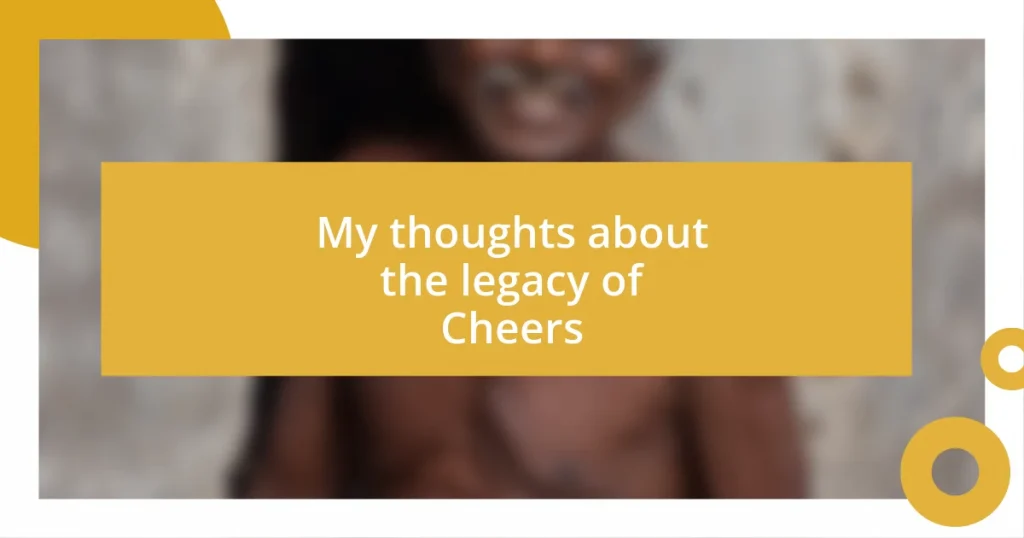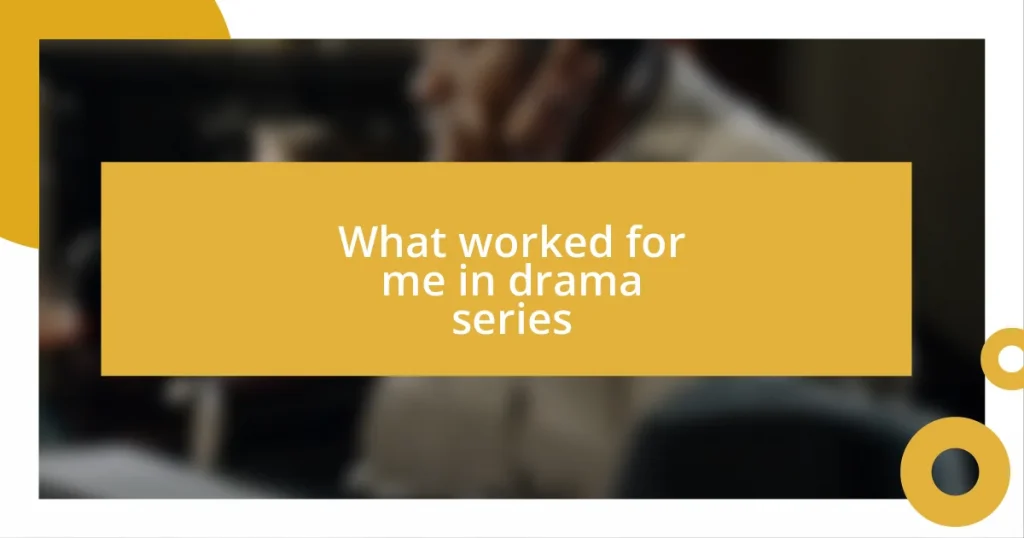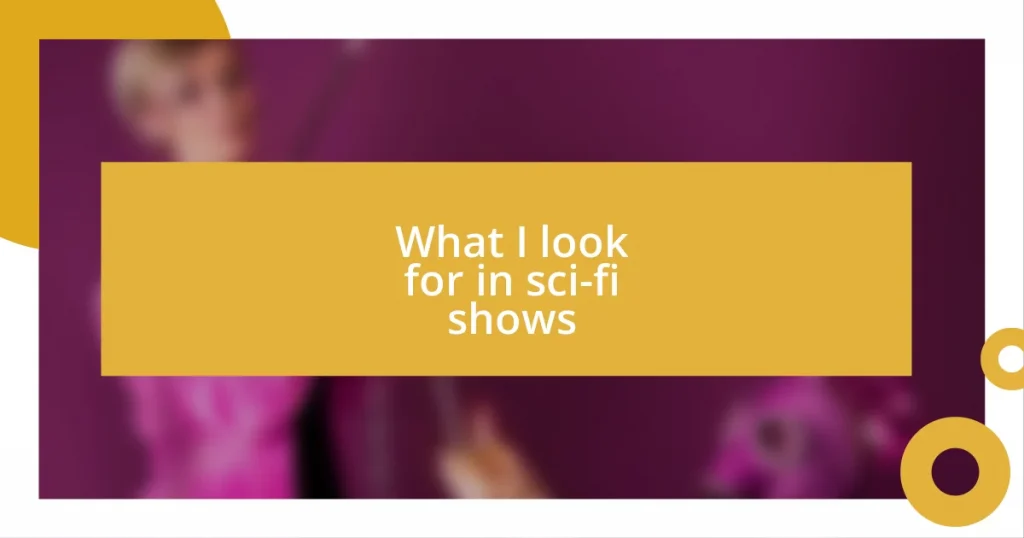Key takeaways:
- “Cheers” profoundly impacted pop culture and set new standards for sitcom storytelling, influencing future shows with its character-driven narratives.
- The ensemble cast showcased memorable characters like Sam Malone, Diane Chambers, and Carla Tortelli, highlighting the balance between humor and genuine emotional connections.
- The show’s themes of community, love, and the blend of humor with serious issues continue to resonate, offering valuable lessons for modern television creators.

Overview of Cheers significance
“Cheers” is not just a television show; it has left an indelible mark on pop culture. I remember the first time I found myself laughing along with the characters in that warm, inviting bar. The camaraderie and humor created a sense of belonging that many viewers, including myself, craved.
What really makes “Cheers” significant is its exploration of relationships and community. It’s fascinating to think about how the show captured the essence of friendship, often making one wonder, can a bar really feel like home? For many, that fictional space became a sanctuary, a place to unwind, share stories, and connect with others, much like real-life bars do.
Additionally, “Cheers” influenced the landscape of sitcoms and storytelling. It broke molds with its character-driven narratives and intricately woven story arcs. I often reflect on how shows today, like “Brooklyn Nine-Nine” or “Parks and Recreation,” owe some of their charm to the legacy of “Cheers.” It set a high bar for character development and humor that resonates even decades later.

Impact on television history
It’s difficult to overstate the impact “Cheers” has had on television history. Looking back, I can trace a thread from “Cheers” to countless sitcoms that followed, each borrowing elements of its charm. The show’s ability to blend humor with heartfelt moments set a new standard in storytelling, encouraging writers to dive deeper into character development and emotional arcs.
- Pioneered the ensemble cast format, showing that chemistry among characters could drive a show’s success.
- Introduced the “bar as a character” concept, demonstrating how a setting can encapsulate community and warmth.
- Set a precedent for spin-offs, with “Frasier” becoming one of the most successful in TV history.
- Reinforced the idea that sitcoms could tackle serious issues, blending humor with poignant life lessons.

Memorable characters and their roles
One of the most remarkable aspects of “Cheers” is its ensemble cast, featuring characters that are as distinct as they are memorable. For instance, Sam Malone, portrayed by Ted Danson, serves as the charming yet flawed bartender who anchors the bar’s social dynamics. His flirtatious nature and sincere vulnerability often resonated with viewers, reminding me of the balance between confidence and insecurities that we all face in relationships.
Then there’s Diane Chambers, played by Shelley Long, who embodies the clash between intellect and emotion. Her presence in the bar challenged the status quo, as she often brought a level of sophistication amidst the lovable chaos. Watching her interact with the constant banter of characters like Cliff Clavin and Norm Peterson, I couldn’t help but feel a sense of nostalgia for those witty repartees shared with friends—a reminder that even the most diverse personalities can create a close-knit community.
Finally, we can’t forget about Carla Tortelli, the no-nonsense waitress with a razor-sharp tongue. Rhea Perlman’s performance always struck a chord with me because it shone a light on the strength embedded in vulnerability. Carla’s fierce loyalty to her friends showcased how even the toughest exteriors can harbor deep emotional connections, making her one of the show’s heartbeats. I find myself thinking about how important these characters were, not just for the laughs, but for the genuine connections they forged in the bar that felt so real.
| Character | Role |
|---|---|
| Sam Malone | Charismatic bartender and former baseball player, providing both humor and emotional depth. |
| Diane Chambers | The sophisticated intellectual who often challenged others with her wit and charm. |
| Carla Tortelli | The fierce waitress known for her loyalty and sharp humor, representing strength in vulnerability. |

Themes that resonate with audiences
The themes in “Cheers” resonate with audiences largely because they reflect the complexities of everyday life. The sense of belonging that the bar provided evoked a deep emotional connection for viewers. Have you ever entered a place where everyone knows your name? That feeling of being part of a community, even if just for half an hour, creates a warm comfort that many of us crave.
Another theme that stands out is the exploration of love in its many forms. Relationships, be it romantic or platonic, are woven throughout the series, illustrating both the joys and struggles we all face. I can think back to moments when watching Sam’s and Diane’s tumultuous love affair mirrored some of my own experiences—those highs and lows were not just entertaining; they were deeply relatable.
Additionally, the show did not shy away from addressing serious life issues, balancing humor with heartfelt lessons. When Norm faced job loss or Carla dealt with family challenges, I found myself reflecting on my own life’s hurdles. These moments remind us that laughter and tears often coexist, encapsulating the beautifully messy reality of human relationships. Isn’t it fascinating that a sitcom could highlight such poignant truths in our lives?

Lessons for modern television creators
The legacy of “Cheers” offers several valuable lessons for modern television creators. One major takeaway is the importance of character depth. When I think about shows today, it strikes me that many overlook the complexity that makes characters relatable. Aren’t we all drawn to stories where we can see parts of ourselves? With well-developed characters like Sam and Diane, creators can craft narratives that invite viewers to invest emotionally.
Another key lesson is the power of ensemble casts. “Cheers” showed how diverse personalities could blend harmoniously, creating a sense of community. I’ve experienced this in my own life—don’t we often find ourselves connecting with a surprising mix of friends? By fostering relationships among a varied group, modern shows can mirror the real-world dynamics that resonate with audiences, offering a richer, more engaging experience.
Finally, the balance between humor and serious themes is vital. I’ve noticed that the most impactful stories I enjoy often use laughter as a tool to explore deeper issues. Think back to how Norm’s struggles with his job became fodder for both comedy and empathy in “Cheers.” This blend not only entertains but also provokes thought, prompting viewers to relate their own challenges to what they see on screen. After all, isn’t life itself a tapestry of laughter and tears?

Lasting cultural references and tributes
The influence of “Cheers” extends far beyond its original run, sparking countless cultural references that continue to resonate. I remember sitting in a bar during a friend’s birthday, and someone shouted, “Where everybody knows your name!” instantly bringing a smile to everyone’s face. That moment reminded me how deeply embedded this show is in our shared cultural psyche—its phrases and scenarios have become shorthand for camaraderie and familiarity.
Tributes to “Cheers” have emerged in various forms, from parodies on late-night television to nods in contemporary sitcoms. I once stumbled upon an episode of a modern show that recreated the iconic bar setting, evoking nostalgia while cleverly commenting on how much things have changed since the original’s heyday. It’s incredible how these tributes not only honor the legacy but also bridge generations of viewers, sparking conversations about our own experiences in communal spaces.
Moreover, I’ve noticed the show’s impact on how we perceive local bars and pubs. Many establishments now refer to themselves as “Cheers-style,” reflecting that same sense of warmth and belonging. Have you ever wandered into a bar that felt like a second home? That’s the magic of “Cheers” living on—reminding us that, no matter where we are, we can create our own little haven where everyone knows our name. Isn’t it heartening to think that the spirit of those characters continues to shape our social interactions?















